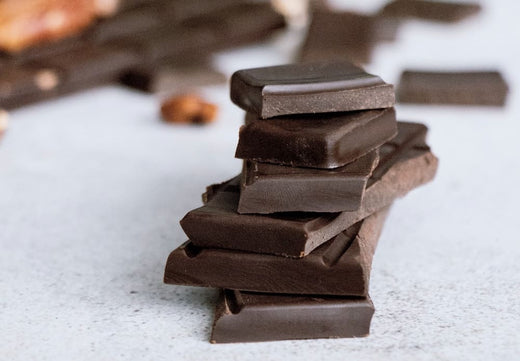In the delicious world of chocolate, understanding the nuances of all the different varieties can be both exciting and bewildering.
The difference between milk, dark, and semi-sweet chocolate might be obvious at one level, yet understanding what truly distinguishes them, particularly in terms of cocoa content, might not.
In this post, we look into this topic by exploring the question: What percentage is semi-sweet chocolate?
Is there a fixed standard, or does it vary by brand and geography?
Read on to unravel the delicious mystery of semi-sweet chocolate and its cocoa percentage.
What Percentage Cocoa Solids is Semi-Sweet Chocolate?
Semi-sweet chocolate typically contains between 35% and 60% cocoa solids.
However, the exact percentage can vary between different manufacturers and regions.
Please always check the packaging for precise information.
What is Semi-Sweet Chocolate?
Semi-sweet chocolate is a type of dark chocolate that is often used in baking and dessert recipes.
It is distinguished by its balance of sweetness and cocoa flavour.
Made from a combination of cocoa solids, cocoa butter, sugar, and sometimes vanilla and lecithin, semi-sweet chocolate typically contains between 35% and 60% cocoa solids.
This balance makes it a versatile ingredient in the kitchen, offering a chocolate flavour that is robust but not too bitter, making it a popular choice in a variety of sweet treats.
However, the exact sweetness can vary between brands, so it is always a good idea to taste it before using it in a recipe.
(Click here if you would like to learn: How to Make Melted Chocolate Thinner)
Where Can You Buy Great Chocolate for Baking and Cooking?
The best type of chocolate for cooking and baking largely depends on the recipe you’re following and your personal taste preferences.
However, here are some general guidelines for different types of chocolate:
-
Dark Chocolate: With its robust, rich flavour, dark chocolate is a versatile choice for many recipes. It’s available in different cocoa percentages, allowing you to choose based on how intense you want the chocolate flavour to be. It’s excellent for ganaches, truffles, and any recipe where a deep chocolate flavour is desired.
-
Semi-Sweet and Bittersweet Chocolate: These are types of dark chocolate, often used interchangeably in recipes. They’re great for baking due to their balanced sweetness and cocoa flavour. Ideal for cookies, brownies, and many other desserts.
-
Milk Chocolate: Sweeter and creamier than dark chocolate, milk chocolate is best used in recipes where a milder, sweeter chocolate flavour is desired. It’s great for making chocolate sauces, fillings, or for use in desserts where its sweetness complements other ingredients.
-
White Chocolate: Although it doesn’t contain cocoa solids, white chocolate brings a creamy, sweet, and slightly vanilla flavour to dishes. It can be used in baking, though it’s more sensitive to heat than other types of chocolate.
-
Couverture Chocolate (like Whitakers Easymelt product): This is a high-quality chocolate that contains a higher percentage of cocoa butter. It’s excellent for tempering and making chocolate decorations due to its smooth texture and shiny finish when melted and cooled.
-
Cocoa Powder: Ideal for adding a chocolatey flavour to cakes, biscuits and frostings, cocoa powder is a staple in many baking recipes. It provides a strong, bitter chocolate flavour without adding any fat or sweetness.
Remember, when it comes to cooking and baking with chocolate, the quality matters.
Higher-quality chocolate will generally produce better results, so it’s worth investing in good chocolate, especially for recipes where chocolate is the star of the show.
(Click here if you want to read about: How Much Cocoa is in Milk Chocolate?)
Final Notes On The Cocoa Percentage of Semi-Sweet Chocolate
It's important to bear in mind that the cocoa percentage of semi-sweet chocolate can vary notably among different manufacturers, typically between 35% and 60%.
This percentage represents the combined weight of both the cocoa solids and the cocoa butter present in the chocolate.
As such, semi-sweet chocolate with a higher cocoa percentage will offer a deeper, more intense cocoa flavour compared to one with a lower percentage.
This is a vital consideration depending on your personal taste preference or the specific requirements of the recipe you're following.
Lastly, despite any variance, semi-sweet chocolate remains an excellent middle-ground choice, providing a perfect balance of sweetness and cocoa flavour for countless baking endeavours and chocolatey delights.
Remember, for the most accurate information on cocoa percentage, always refer to the product's packaging or reach out to the manufacturer.
Savouring chocolate is as much about understanding its complexities as it is about enjoying its taste.
Before you go, you might also like to read this post asking: What is Bittersweet Chocolate UK?











